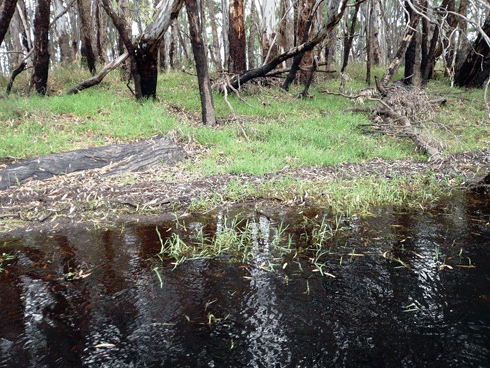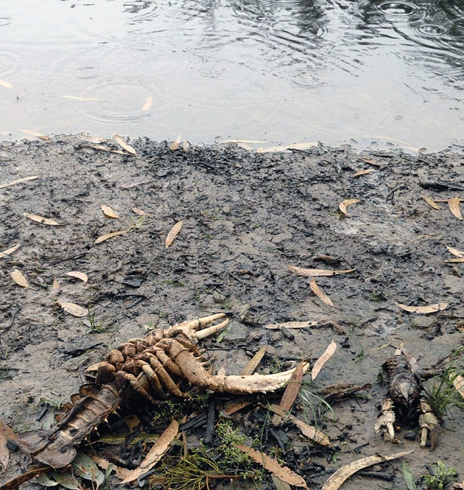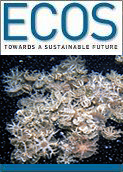
|
Published: 17 September 2012
Blackwater: the dark side of drought-breaking floods
In late 2010, after years of severe drought, heavy rains fell over much of the southern Murray-Darling Basin. While the rain and subsequent flooding were celebrated as a return to normal weather conditions, many river systems suffered from the lethal effects of ‘blackwater’ – poorly oxygenated water that can kill aquatic life.

|
|
The dark, oxygen-depleted water that killed large numbers of native aquatic animals in Murray River floodwaters during 2010-11. Credit:
A. King
|
Our research team focused on the Barmah–Millewa Forest floodplain on the Victoria–New South Wales border, which was inundated with heavy rain from July 2010 to April 2011 after five years of no flooding.
The combination of floodwaters, warm temperatures and large amounts of dead plant material on the floodplain produced what is known as blackwater – characteristically dark water that is low in oxygen. The low oxygen levels are caused by the rapid bacterial consumption of high levels of dissolved organic carbon in the water, which comes from the accumulation of leaf litter and other forms of organic carbon during the drought.
Although blackwater is a natural and important part of river systems, in some cases, it can have drastic consequences on aquatic life.
From November 2010 to April 2011, this significant blackwater plume from the Barmah–Millewa Forest flowed into the Murray River. Dissolved oxygen levels in the Murray River dropped by up to 95 per cent – critically low levels – with the plume initially extending up to 50 km from the Barmah Lakes region to Echuca.
In the first few weeks of the blackwater event, there were reports of unusual behaviour in the region’s aquatic life: large numbers of Murray crayfish emerging from the water, dead Murray cod floating in the water, and large numbers of small fish schooling and surface-breathing in the shallow river margins.
After sampling unaffected and affected sites at the beginning and the middle of the blackwater event, our team found major effects on several aquatic life-forms, including fish, shrimp and Murray crayfish.
Murray crayfish – a large iconic invertebrate species endemic to the Murray and Murrumbidgee River catchments – is popular with recreational fishers. Once abundant, its numbers and distribution appear to be rapidly decreasing, and the species is listed as threatened in some states, including Victoria and New South Wales.
When we first sampled the area at the beginning of the blackwater event, we saw large numbers of Murray crayfish of all sizes at the water’s edge. The animals were in a lethargic state and frequently re-immersed themselves, presumably to moisten their gills.
We also saw what we estimated to be thousands of live or dead shrimp and smaller numbers of yabbies at the water’s edge.
However, by the time we sampled the area again in February, we saw no crayfish or shrimp. The exposed crayfish had probably been illegally harvested, eaten by predators or killed by the anoxia or toxins in the water.

|
|
Dead Murray crayfish and shrimp at the edge of the blackwater. Credit:
A. King
|
The effects of the blackwater on the fish community were more complex, but just as significant. There were fewer native fish in blackwater-affected areas than in unaffected sites, and although similar numbers of smaller-bodied native species were found in both areas at the beginning of the blackwater event, there were far fewer in affected sites than in unaffected sites in the second survey.
Overall, native species were hit quite hard by the blackwater, whereas pest species – particularly juvenile carp – remained highly abundant. This was presumably due to the pest species’ higher tolerance of anoxic conditions.
Although limited in its scope, our study suggests the 2010–2011 blackwater event may have had a substantial effect on the Murray River’s aquatic fauna, particularly those of high recreational value, such as Murray cod and Murray crayfish. Only further research and monitoring can assess the longer-term impacts of this event in particular, and blackwater in general.
Understanding the causes of blackwater is just as important as investigating its effects.
This blackwater event was caused by heavy rainfall and subsequent flooding of Barmah–Millewa Forest; however, the severity of the preceding drought, no floodplain inundation during the drought and the effects of river regulation all contributed to the accumulation of leaf litter and other forms of organic carbon that fuelled the event.
With climate change predicted to lead to more extreme weather events, we need to be prepared for more frequent, potentially catastrophic events such as blackwater after prolonged droughts. Environmental managers could help alleviate the amount of fuel available for blackwater events by taking steps to reduce the amount of leaf litter in flood-prone areas. Where possible, managers should also consider inundating the floodplain in cooler periods, particularly after prolonged dry spells. Pooling water on floodplains for extended periods and then returning this water to rivers needs to be carefully managed for the benefit of the receiving waters.
Alison King is at the Research Institute for the Environment and Livelihoods at Charles Darwin University. Zeb Tonkin and Jason Lieschke are based at the Arthur Rylah Institute for Environmental Research in the Department of Sustainability and Environment in Victoria.
More information
King A, Tonkin Z, Lieshcke J (2012) Short-term effects of a prolonged blackwater event on aquatic fauna in the Murray River, Australia: considerations for future events. Marine and Freshwater Research 63: 576-586.



